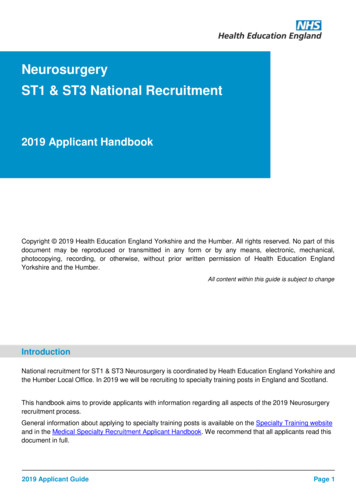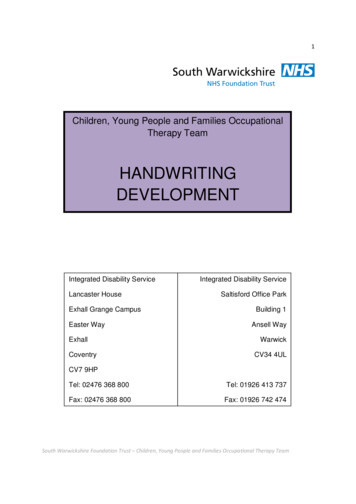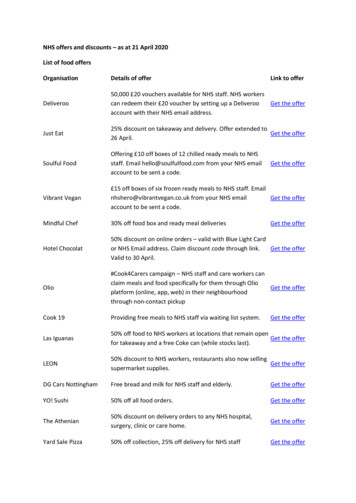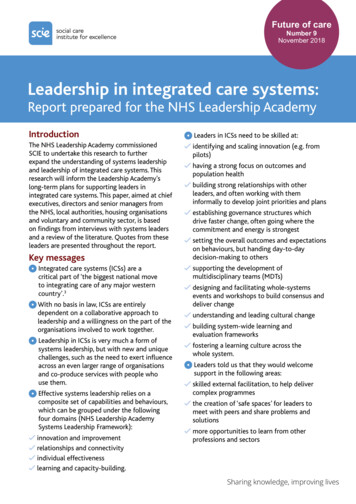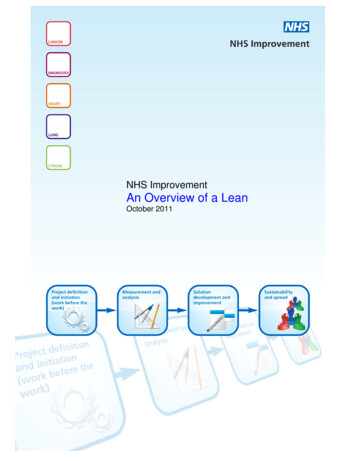
Transcription
NHS ImprovementAn Overview of a LeanOctober 2011
Table of ContentsLean . . 3A Brief History of Lean . . 3Lean Today . .4Principles of Lean . .5Getting Started . 6Common Lean Questions .6How do I get started . . 7Is there an essential implementation sequence and if so, what is it?. 7Does lean apply to non-manufacturing settings?. 8What are the most common mistakes in implementing lean?. 8How does lean compare to other improvement processes such as Six Sigma?. 8How does lean compare with the Theory of Constraints, or TOC?.9How do I convince my leaders and associates to practice lean?.9What are the best books about Lean practice?.10NHS Improvement2August 2011
LeanLean is an improvement approach to improve flow and eliminate waste. Lean is basically aboutgetting the right things to the right place, at the right time, in the right quantities, while minimisingwaste and being flexible and open to change.Lean is a whole management system which brings into many industries, including healthcare,new concepts, tools and methods that have been effectively utilised to improve process flow.Tools that address workplace organisation, standardisation, visual control and elimination of nonvalue added steps are applied to improve flow, eliminate waste and exceed customerexpectations.A Brief History of LeanAlthough there are instances of rigorous process thinking in manufacturing all the way back tothe Arsenal in Venice in the 1450s, the first person to truly integrate an entire production processwas Henry Ford. At Highland Park, MI, in 1913 he married consistently interchangeable partswith standard work and moving conveyance to create what he called flow production. The publicgrasped this in the dramatic form of the moving assembly line, but from the standpoint of themanufacturing engineer the breakthroughs actually went much further.Ford lined up fabrication steps in process sequence wherever possible using special-purposemachines and go/no-go gauges to fabricate and assemble the components going into the vehiclewithin a few minutes, and deliver perfectly fitting components directly to line-side. This was atruly revolutionary break from the shop practices of the American System that consisted ofgeneral-purpose machines grouped by process, which made parts that eventually found theirway into finished products after a good bit of tinkering (fitting) in subassembly and final assembly.The problem with Ford’s system was not the flow: He was able to turn the inventories of theentire company every few days. Rather it was his inability to provide variety. The Model T wasnot just limited to one colour. It was also limited to one specification so that all Model T chassiswere essentially identical up through the end of production in 1926. (The customer did have achoice of four or five body styles, a drop-on feature from outside suppliers added at the very endof the production line.) Indeed, it appears that practically every machine in the Ford MotorCompany worked on a single part number, and there were essentially no changeovers.When the world wanted variety, including model cycles shorter than the 19 years for the Model T,Ford seemed to lose his way. Other automakers responded to the need for many models, eachwith many options, but with production systems whose design and fabrication steps regressedtoward process areas with much longer throughput times. Over time they populated theirfabrication shops with larger and larger machines that ran faster and faster, apparently loweringcosts per process step, but continually increasing throughput times and inventories except in therare case—like engine machining lines—where all of the process steps could be linked andautomated. Even worse, the time lags between process steps and the complex part routingsrequired ever more sophisticated information management systems culminating in computerizedMaterials Requirements Planning (MRP) systems.As Kiichiro Toyoda, Taiichi Ohno, and others at Toyota looked at this situation in the 1930s, andmore intensely just after World War II, it occurred to them that a series of simple innovationsmight make it more possible to provide both continuity in process flow and a wide variety inNHS Improvement3August 2011
product offerings. They therefore revisited Ford’s original thinking, and invented the ToyotaProduction System.This system in essence shifted the focus of the manufacturing engineer from individual machinesand their utilization, to the flow of the product through the total process. Toyota concluded thatby right-sizing machines for the actual volume needed, introducing self-monitoring machines toensure quality, lining the machines up in process sequence, pioneering quick setups so eachmachine could make small volumes of many part numbers, and having each process step notifythe previous step of its current needs for materials, it would be possible to obtain low cost, highvariety, high quality, and very rapid throughput times to respond to changing customer desires.Also, information management could be made much simpler and more accurate.The thought process of lean was thoroughly described in the book The Machine That Changedthe World (1990) by James P. Womack, Daniel Roos, and Daniel T. Jones. In a subsequentvolume, Lean Thinking (1996), James P. Womack and Daniel T. Jones distilled these leanprinciples even further to five: Specify the value desired by the customerIdentify the value stream for each product providing that value and challenge all of thewasted steps currently necessary to provide itMake the product flow continuously through the remaining, value-added stepsIntroduce pull between all steps where continuous flow is currently impossibleManage toward perfection so that the number of steps and the amount of time andinformation needed to serve the customer continually fallsLean TodayToyota is the leading lean exemplar in the world and stands poised to become the largestautomaker in the world in terms of overall sales. Its dominant success in everything from risingsales and market shares in every global market, not to mention a clear lead in hybrid technology,stands as the strongest proof of the power of lean enterprise.This continued success has over the past two decades created an enormous demand for greaterknowledge about lean thinking. There are literally hundreds of books and papers, not to mentionthousands of media articles exploring the subject, and numerous other resources available tothis growing audience.As lean thinking continues to spread to every country in the world, leaders are also adapting thetools and principles beyond manufacturing, to logistics and distribution, services, retail,healthcare, construction, maintenance, and even government. Indeed, lean consciousness andmethods are only beginning to take root among senior managers and leaders in all sectorstoday.NHS Improvement4August 2011
Principles of Lean:1Specify ValueAs Womack and Jones note in Lean Thinking, "The critical starting point for lean thinking is value.Value can only be defined by the ultimate customer. And it's only meaningful when expressed interms of a specific product (a good or a service, and often both at once), which meets thecustomer's needs at a specific price at a specific time."Above all, lean practitioners must be relentlessly focused on the customer when specifying andcreating value. Neither shareholder needs, nor senior management¹s financial mind-set, norpolitical exigencies, nor any other consideration should distract from this critical first step in leanthinking. Once more, here¹s another passage from Womack and Jones on how managers canstart off on the wrong path:Why is it so hard to start at the right place, to correctly define value?“Partly because most producers want to make what they are already making and partly becausemany customers only know how to ask for some variant of what they are already getting. Theysimply start in the wrong place and end up at the wrong destination. Then, when providers orcustomers do decide to rethink value, they often fall back on formulas: lower cost, increasedproduct variety through customization, instant delivery rather than jointly analyzing value andchallenging old definitions to see what is really needed."2Identify the Value StreamThe value stream is the set of all the specific actions required to bring a specific product throughthe critical management tasks of any business: the problem-solving task running from conceptthrough detailed design and engineering to production launch, the information management taskrunning from order-taking through detailed scheduling to delivery, and the physicaltransformation task proceeding from raw materials to a finished product in the hands of thecustomer. Identifying the entire value stream for each product is the next step in lean thinking, astep which firms have rarely attempted but which almost always exposes enormous, indeedstaggering, amounts of waste.A great resource and guide to Value Stream mapping is Learning to See by Mike Rother andJohn Shook.3FlowOnly after specifying value and mapping the stream can lean thinkers implement the thirdprinciple of making the remaining, value-creating steps flow. Such a shift often requires afundamental shift in thinking for everyone involved, as functions and departments that onceserved as the categories for organizing work must give way to specific products; and a "batchand queue" production mentality must get used to small lots produced in continuous flow.Interestingly, "flow" production was an even more valuable innovation of Henry Ford¹s than hisbetter-known "mass" production model.NHS Improvement5August 2011
Lean managers eager to implement flow in their organizations can learn more about the topic inthe book Creating Continuous Flow by Mike Rother and Rick Harris.4Customer PullAs a result of the first three principles, lean enterprises can now make a revolutionary shift:instead of scheduling production to operate by a sales forecast, they can now simply make whatthe customer tells them to make. As Womack and Jones state, "You can let the customer pullthe product from you as needed rather than pushing products, often unwanted, onto thecustomer." In other words, no one upstream function or department should produce a good orservice until the customer downstream asks for it.5Pursue PerfectionAfter having implemented the prior lean principles, it "dawns on those involved that there is noend to the process of reducing effort, time, space, cost, and mistakes while offering a productwhich is ever more nearly what the customer actually wants," write Womack and Jones."Suddenly perfection, the fifth and final principle, doesn¹t seem like a crazy idea."Getting StartedWelcome to lean. As you begin your lean journey, it is important to recognize two critical points:the road ahead is daunting—yet the potential payoff from your effort is enormous.Jim Womack and Dan Jones define the promise of lean thinking as“a way to specify value, line up value-creating actions in the best sequence, conductthose activities without interruption whenever someone requests them, and perform themmore and more effectively. In short, lean thinking is lean because it provides a way to domore and more with less and less—less human effort, less human equipment, less time,and less space—while coming closer and closer to providing customers with exactly whatthey want.”And yet, in his foreword to Jeff Liker’s book Becoming Lean, Jim Womack also acknowledgesthe tough job of putting lean into practice.“Why is lean thinking and lean manufacturing so challenging to implement? It is not—asmany early commentators believed—a set of isolated techniques, but a completebusiness system, a way of designing, selling, and manufacturing complex products thatrequires the cooperation of thousands of people and hundreds of independentorganizations. A successful ‘lean leap’ requires ‘change agent’ leadership, a sensei(teacher) to demonstrate the techniques, a long-term commitment to the work force toinspire their best efforts, proactive development of the supply base, aggressivemanagement of the distribution and sales system (accounting methods plus individualcompensation) that motivates managers to do the right thing every time.”Common Lean Questions How do I get started? Is there an essential implementation sequence and if so, what is it? Does lean apply to non-manufacturing settings? What are the most common mistakes in implementing lean? How does lean compare to other improvement processes such as Six Sigma?NHS Improvement6August 2011
How does lean compare with the Theory of Constraints, or TOC?How do I convince my leaders and associates to practice lean?What are the best books about lean practice? How do I get started?While every individual or company embarking on a lean journey will have different challengesbased on their particular set of circumstances, there are several crucial steps that can helpreduce resistance, spread the right learning, and engender the type of commitment necessaryfor lean enterprise. One of the best overall guides to getting started on your lean journey can befound in Chapter 11 of the book Lean Thinking, appropriately titled, An Action Plan. Here are thekey steps as they are elaborated: Find a change agent. This could be you—or anyone of the organization: the key is thatthis must be a leader who will take personal responsibility for the lean transformation.Get the lean knowledge. It’s important to draw from a true and thorough source o
the book Creating Continuous Flow by Mike Rother and Rick Harris. 4 Customer Pull As a result of the first three principles, lean enterprises can now make a revolutionary shift: instead of scheduling production to operate by a sales forecast, they can now simply make what the customer tells them to make. As Womack and Jones state, "You can let the customer pull the product from you as needed .




